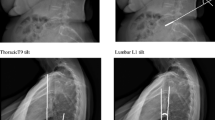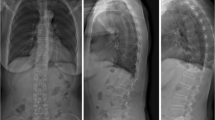Abstract
Summary
Due to missing indications for specific diagnostics, the majority of non-symptomatic vertebral fractures are not diagnosed. This study shows the ability of radiation-free spinometry to assess sagittal spine parameters to raise suspicion for new non-traumatic thoracic and lumbar vertebral fractures and indicate specific diagnostics.
Introduction
The primary aim of this study was to investigate the accuracy of radiation-free spinometry to predict new non-traumatic vertebral fractures (VF) by the assessment of thoracic kyphosis (TK), lumbar lordosis (LL), and trunk inclination.
Methods
Three hundred sixty-one patients (278 females and 83 males; age, 67.0 ± 8.6 years) were enrolled. In 86 women and 24 men, at least one non-traumatic VF was confirmed by radiography, MRI, and/or CT. Spinometry (video rasterstereography) was used to assess TK, LL, and trunk inclination. Receiver operating characteristic (ROC) and multivariate logistic regression analyses were performed to test the influence of age, sex, number, location, and grade of fractures on sagittal spine alignment.
Results
TK, LL, and trunk inclination were associated with advancing age (p < 0.05). Patients with prevalent thoracic and lumbar VFs showed increased TK (p < 0.001), decreased LL (p < 0.001), and increased trunk inclination (p < 0.001) in comparison to patients without VFs. ROC analysis revealed that the combination of TK and LL presented with the best predictive accuracy to raise suspicion for new grade 2 or grade 3 VFs in the thoracic and the lumbar spine (AUC, 0.752–0.771). Odds ratio (OR) showed an increased risk for VFs with increased TK (OR, 1.05–1.11; p < 0.001) and LL (1.05–1.07; p < 0.001) in specified regions of interest. A TK <50° (sensitivity, 88–100 %; specificity, 23–25 %) and LL (78–92 %; 24–27 %) were considered as appropriate cutoffs for future screening.
Conclusion
Spinometry showed better predictive accuracy than historical height loss. Severe changes of TK and LL may help to raise suspicion of new VFs radiation-free and indicate proper diagnostics, such as radiographs, MRI, or CT.




Similar content being viewed by others
References
Cooper C (1993) Epidemiology and public health impact of osteoporosis. Baillieres Clin Rheumatol 7(3):459–477
Francis RM, Aspray TJ, Hide G, Sutcliffe AM, Wilkinson P (2008) Back pain in osteoporotic vertebral fractures. Osteoporos Int: J Eur Found Osteoporos Natl Osteoporos Found USA 19(7):895–903. doi:10.1007/s00198-007-0530-x
Lindsay R, Silverman SL, Cooper C, Hanley DA, Barton I, Broy SB, Licata A, Benhamou L, Geusens P, Flowers K, Stracke H, Seeman E (2001) Risk of new vertebral fracture in the year following a fracture. JAMA: J Am Med Assoc 285(3):320–323
Silverman SL, Piziak VK, Chen P, Misurski DA, Wagman RB (2005) Relationship of health related quality of life to prevalent and new or worsening back pain in postmenopausal women with osteoporosis. J Rheumatol 32(12):2405–2409
Ensrud KE, Black DM, Harris F, Ettinger B, Cummings SR (1997) Correlates of kyphosis in older women. The fracture intervention trial research group. J Am Geriatr Soc 45(6):682–687
Katzman WB, Vittinghoff E, Ensrud K, Black DM, Kado DM (2011) Increasing kyphosis predicts worsening mobility in older community-dwelling women: a prospective cohort study. J Am Geriatr Soc 59(1):96–100. doi:10.1111/j.1532-5415.2010.03214.x
Ryan SD, Fried LP (1997) The impact of kyphosis on daily functioning. J Am Geriatr Soc 45(12):1479–1486
Hirose D, Ishida K, Nagano Y, Takahashi T, Yamamoto H (2004) Posture of the trunk in the sagittal plane is associated with gait in community-dwelling elderly population. Clin Biomech (Bristol, Avon) 19(1):57–63
Lynn SG, Sinaki M, Westerlind KC (1997) Balance characteristics of persons with osteoporosis. Arch Phys Med Rehabil 78(3):273–277
Sinaki M, Brey RH, Hughes CA, Larson DR, Kaufman KR (2005) Balance disorder and increased risk of falls in osteoporosis and kyphosis: significance of kyphotic posture and muscle strength. Osteoporos Int: J Eur Found Osteoporos Natl Osteoporos Found USA 16(8):1004–1010. doi:10.1007/s00198-004-1791-2
Ishikawa Y, Miyakoshi N, Kasukawa Y, Hongo M, Shimada Y (2009) Spinal curvature and postural balance in patients with osteoporosis. Osteoporos Int: J Eur Found Osteoporos Natl Osteoporos Found USA 20(12):2049–2053. doi:10.1007/s00198-009-0919-9
Center JR, Nguyen TV, Schneider D, Sambrook PN, Eisman JA (1999) Mortality after all major types of osteoporotic fracture in men and women: an observational study. Lancet 353(9156):878–882. doi:10.1016/S0140-6736(98)09075-8
Cauley JA, Thompson DE, Ensrud KC, Scott JC, Black D (2000) Risk of mortality following clinical fractures. Osteoporos Int: J Eur Found Osteoporos Natl Osteoporos Found USA 11(7):556–561
Kado DM, Browner WS, Palermo L, Nevitt MC, Genant HK, Cummings SR (1999) Vertebral fractures and mortality in older women: a prospective study. Study of osteoporotic fractures research group. Arch Intern Med 159(11):1215–1220
Duboeuf F, Bauer DC, Chapurlat RD, Dinten JM, Delmas P (2005) Assessment of vertebral fracture using densitometric morphometry. J Clin Densitom: Off J Int Soc Clin Densitom 8(3):362–368
Jacobs-Kosmin D, Sandorfi N, Murray H, Abruzzo JL (2005) Vertebral deformities identified by vertebral fracture assessment: associations with clinical characteristics and bone mineral density. J Clin Densitom: Off J Int Soc Clin Densitom 8(3):267–272
DVO (2011) Guideline 2009 for prevention, diagnosis and therapy of osteoporosis in adults. Osteologie 20:55–74
Siminoski K, Jiang G, Adachi JD, Hanley DA, Cline G, Ioannidis G, Hodsman A, Josse RG, Kendler D, Olszynski WP, Ste Marie LG, Eastell R (2005) Accuracy of height loss during prospective monitoring for detection of incident vertebral fractures. Osteoporos Int: J Eur Found Osteoporos Natl Osteoporos Found USA 16(4):403–410. doi:10.1007/s00198-004-1709-z
Siminoski K, Warshawski RS, Jen H, Lee K (2006) The accuracy of historical height loss for the detection of vertebral fractures in postmenopausal women. Osteoporos Int: J Eur Found Osteoporos Natl Osteoporos Found USA 17(2):290–296. doi:10.1007/s00198-005-2017-y
Lewiecki EM, Laster AJ (2006) Clinical review: clinical applications of vertebral fracture assessment by dual-energy x-ray absorptiometry. J Clin Endocrinol Metab 91(11):4215–4222. doi:10.1210/jc.2006-1178
Huang MH, Barrett-Connor E, Greendale GA, Kado DM (2006) Hyperkyphotic posture and risk of future osteoporotic fractures: the Rancho Bernardo study. J Bone Miner Res Off J Am Soc Bone Miner Res 21(3):419–423. doi:10.1359/JBMR.051201
De Smet AA, Robinson RG, Johnson BE, Lukert BP (1988) Spinal compression fractures in osteoporotic women: patterns and relationship to hyperkyphosis. Radiology 166(2):497–500
Drerup B, Hierholzer E (1985) Objective determination of anatomical landmarks on the body surface: measurement of the vertebra prominens from surface curvature. J Biomech 18(6):467–474
Liljenqvist U, Halm H, Hierholzer E, Drerup B, Weiland M (1998) 3-dimensional surface measurement of spinal deformities with video rasterstereography. Z Orthop Grenzgeb 136(1):57–64. doi:10.1055/s-2008-1044652
Lippold C, Danesh G, Schilgen M, Drerup B, Hackenberg L (2006) Sagittal jaw position in relation to body posture in adult humans—a rasterstereographic study. BMC Musculoskelet Disord 7:8. doi:10.1186/1471-2474-7-8
Schulte TL, Hierholzer E, Boerke A, Lerner T, Liljenqvist U, Bullmann V, Hackenberg L (2008) Raster stereography versus radiography in the long-term follow-up of idiopathic scoliosis. J Spinal Disord Tech 21(1):23–28. doi:10.1097/BSD.0b013e318057529b
Hackenberg L, Hierholzer E, Potzl W, Gotze C, Liljenqvist U (2003) Rasterstereographic back shape analysis in idiopathic scoliosis after posterior correction and fusion. Clin Biomech (Bristol, Avon) 18(10):883–889
Mohokum M, Mendoza S, Udo W, Sitter H, Paletta JR, Skwara A (2010) Reproducibility of rasterstereography for kyphotic and lordotic angles, trunk length, and trunk inclination: a reliability study. Spine 35(14):1353–1358. doi:10.1097/BRS.0b013e3181cbc157
WHO (1994) Assessment of fracture risk and its application to screening for postmenopausal osteoporosis. Geneva: WHO; 1994 No 843 (Technical Report Series. )
Genant HK, Wu CY, van Kuijk C, Nevitt MC (1993) Vertebral fracture assessment using a semiquantitative technique. J Bone Miner Res Off J Am Soc Bone Miner Res 8(9):1137–1148. doi:10.1002/jbmr.5650080915
Delmas PD, van de Langerijt L, Watts NB, Eastell R, Genant H, Grauer A, Cahall DL (2005) Underdiagnosis of vertebral fractures is a worldwide problem: the IMPACT study. J Bone Miner Res Off J Am Soc Bone Miner Res 20(4):557–563. doi:10.1359/JBMR.041214
Binkley N, Krueger D, Gangnon R, Genant HK, Drezner MK (2005) Lateral vertebral assessment: a valuable technique to detect clinically significant vertebral fractures. Osteoporos Int: J Eur Found Osteoporos Natl Osteoporos Found USA 16(12):1513–1518. doi:10.1007/s00198-005-1891-7
El Maghraoui A, Mounach A, Rezqi A, Achemlal L, Bezza A, Ghozlani I (2012) Vertebral fracture assessment in asymptomatic men and its impact on management. Bone 50(4):853–857. doi:10.1016/j.bone.2011.12.018
Drerup B, Hierholzer E (1987) Automatic localization of anatomical landmarks on the back surface and construction of a body-fixed coordinate system. J Biomech 20(10):961–970
Lyon R, Liu XC, Thometz JG, Nelson ER, Logan B (2004) Reproducibility of spinal back-contour measurements taken with raster stereography in adolescent idiopathic scoliosis. Am J Orthop (Belle Mead NJ) 33(2):67–70
Stokes IA, Moreland MS (1987) Measurement of the shape of the surface of the back in patients with scoliosis. The standing and forward-bending positions. The Journal of Bone and Joint Surgery American Volume 69(2):203–211
Stokes IA, Moreland MS (1989) Concordance of back surface asymmetry and spine shape in idiopathic scoliosis. Spine 14(1):73–78
Hackenberg L, Hierholzer E, Potzl W, Gotze C, Liljenqvist U (2003) Rasterstereographic back shape analysis in idiopathic scoliosis after anterior correction and fusion. Clin Biomech (Bristol, Avon) 18(1):1–8
Drerup B (1982) The measurement of the kyphotic angle by contact free registration of back-shape (author's transl). Z Orthop Grenzgeb 120(1):64–70. doi:10.1055/s-2008-1051577
Lewis MK, Blake GM (1995) Patient dose in morphometric X-ray absorptiometry. Osteoporos Int: J Eur Found Osteoporos Natl Osteoporos Found USA 5(4):281–282
Schneider DL, von Muhlen D, Barrett-Connor E, Sartoris DJ (2004) Kyphosis does not equal vertebral fractures: the Rancho Bernardo study. J Rheumatol 31(4):747–752
Takeda N, Kobayashi T, Atsuta Y, Matsuno T, Shirado O, Minami A (2009) Changes in the sagittal spinal alignment of the elderly without vertebral fractures: a minimum 10-year longitudinal study. J Orthop Sci Off J Japan Ortho Assoc 14(6):748–753. doi:10.1007/s00776-009-1394-z
Gelb DE, Lenke LG, Bridwell KH, Blanke K, McEnery KW (1995) An analysis of sagittal spinal alignment in 100 asymptomatic middle and older aged volunteers. Spine 20(12):1351–1358
Schousboe JT, Debold CR (2006) Reliability and accuracy of vertebral fracture assessment with densitometry compared to radiography in clinical practice. Osteoporos Int: J Eur Found Osteoporos Natl Osteoporos Found USA 17(2):281–289. doi:10.1007/s00198-005-2010-5
Vokes T, Bachman D, Baim S, Binkley N, Broy S, Ferrar L, Lewiecki EM, Richmond B, Schousboe J (2006) Vertebral fracture assessment: the 2005 ISCD Official Positions. J Clin Densitom: Off J Int Soc Clin Densitom 9(1):37–46. doi:10.1016/j.jocd.2006.05.006
Conflicts of interest
None.
Author information
Authors and Affiliations
Corresponding author
Additional information
Authors M. Krause, S. Breer, and B. Mohrmann contributed equally to this work and therefore share first authorship.
Rights and permissions
About this article
Cite this article
Krause, M., Breer, S., Mohrmann, B. et al. Influence of non-traumatic thoracic and lumbar vertebral fractures on sagittal spine alignment assessed by radiation-free spinometry. Osteoporos Int 24, 1859–1868 (2013). https://doi.org/10.1007/s00198-012-2156-x
Received:
Accepted:
Published:
Issue Date:
DOI: https://doi.org/10.1007/s00198-012-2156-x




